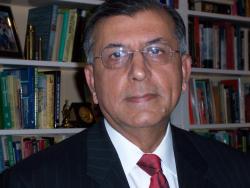
Shuja Nawaz, director of the South Asia Center at the Atlantic Council, testified before the House Armed Service Committee about the future of the U.S.-Pakistan military partnership.
His prepared comments are reproduced below.
Mr. Chairman, Ranking Member, Members of the Committee, I am honored to be asked to speak about this important issue before your committee today. We at the Atlantic Council recently produced a report on Pakistan that offers detailed suggestions on aid for that country.
The United States and Pakistan have had a roller-coaster relationship, marked with highs of deep friendship followed by estrangement. The two countries now are partners again in an attempt to roll back the tide of obscurantism and militancy that grips Afghanistan and Pakistan today. Yet, a deep distrust marks this relationship arising out of the pattern of engagement. This distrust is rooted in both perceptions and reality.
The United States befriended Pakistan most often when it had autocratic rulers and provided the most aid to Pakistan during periods of autocratic rule when Pakistan was seen as an ally of US strategic interests in the region. The intervening periods of civilian rule often were marked by distance and coolness. And a strong perception was created over time in Pakistani minds that the United States did not understand or care for Pakistan’s domestic needs or security concerns.
Mr. Chairman, Pakistan lives in a tough neighborhood. It is in the shadow of India, a major nuclear power to the east, and powerful neighbors such as China, Iran, and an unstable Afghanistan. Internally it is wracked by a rising militancy that is attempting to force its convoluted view of Islam on a largely moderate population. Pakistan has suffered repeated military rule and corrupt civilian governments that often were in the hands of a feudalistic elite or family-run political parties. Over shadowing all this is a powerful and well organized Pakistan army that repeatedly used its coercive power to take charge of the country.
Today, the United States and Pakistan are at a new crossroads: there is an opportunity to forge a new relationship between the people of the two countries and to overturn the historical patterns. Civil society in Pakistan is on the rise and deserves support. The Chief of army staff of the Pakistan army is publicly committed to withdrawing the army from politics, and the new Administration in Washington is committed to a strategy to help build Pakistan via a long-term assistance program that will strengthen its defence while improving the economy. If Washington succeeds in these efforts, it will help break the yo-yo pattern of the US-Pakistan relationship.
But there are challenges to overcome:
- The US must ensure that its aid is not seen solely in support of its battle in Afghanistan and directed largely toward the border region of Pakistan
- This aid must not be seen by the people of Pakistan as short-term and aimed at propping up any single person, party, or group.
- The US and its allies must attempt to reduce the causes of regional hostility between India and Pakistan.
- Pakistan needs to ensure that its government prepares viable and practicable plans for using economic aid effectively and efficiently and controls corruption so aid reaches the poorest segments of society.
- The government of Pakistan also needs to craft a broad consensus in support of a strategy to fight the militants, and strengthen the hands of the silent and moderate majority.
- Pakistan also needs to accelerate the doctrinal shift from conventional military thinking to counterinsurgency and build its capacity to reclaim the areas of militancy. The civilians can then hold and re-build those areas.
Certain key elements of US aid will be needed in this regard:
- First, there must a focus on building up police and para-military capacity to isolate militants from within the communities.
- Second, community-based assistance and a heavy investment in infrastructure, such as roads and bridges, are needed to help aid reach target communities directly. The current system of aid flows must change so aid money is not soaked up by expensive overheads in Washington, Islamabad, or provincial capitals.
- Third, the ability of the Pakistan army to fight a mobile militancy should be enhanced by proving it more heli-lift capability, helicopter gunships, transport, and night vision goggles.
- Fourth, the IMET training program for Pakistan’s military needs to rise dramatically and additional training needs to be organized in the country and in the region to expose larger numbers officers at all ranks to new thinking on counterinsurgency.
- Finally, I suggest strongly that the current Coalition Support Fund model of reimbursement for Pakistani operations in the border region should be ended. This is a cause of deep resentment in the army and civil society since it makes the Pakistani army a “hired force” and makes this America’s War not Pakistan’s own war. Let both sides agree to the objectives, benchmarks, and indicators of success and let the US provide aid for those broad objectives without detailed accounting. We need to rebuild trust between these two allies. Questioning reimbursement claims has the opposite effect.
Mr. Chairman, I do not believe in blank checks. Mutually agreed conditions of aid, rather that unilaterally imposed conditions are the best way of engendering trust. We have to make sure that we set targets that help Pakistan achieve its potential, while ensuring its security and integrity. Creating a safe neighborhood in South Asia will help toward that end.
Thank you Mr. Chairman, Ranking Member, and Members of the Committee. I am prepared to answer your questions.